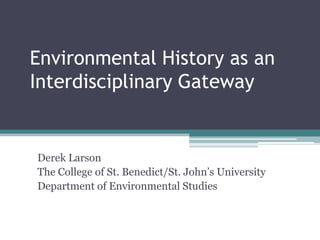
Environmental History as an Interdisciplinary Gateway
- 1. Environmental History as an Interdisciplinary Gateway Derek Larson The College of St. Benedict/St. John’s University Department of Environmental Studies
- 2. History requires consideration of… •Change over time •Historical context •Historical causation •Historical contingency “Nature class,” Spence School New York City, 1930 Photo: Library of Congress
- 3. Environmental history is… •The study of change over time, uniting natural and human history •The history of natural systems •The history of the human/nature relationship •The cultural history of “nature” as a construct •A broadly interdisciplinary field
- 4. Sustainability… •Appears in economics literature in 1950s (as “sustainable growth”) •Takes on contemporary meaning of “the property of being environmentally sustainable” 1980 •U.N. Brundtland definition of sustainable development as “development that meets the needs of the present without compromising the ability of future generations to meet their own needs” 1987 •“Triple bottom line” of social, economic and environmental sustainability 1995
- 5. Questions we might ask… • What made a past practice sustainable (or not)? •How did a practice change over time to make it more or less sustainable? •What can we learn from past practices to improve sustainability today?
- 6. Example: Great Plains Bison • Everyone “knows” what happened to the bison in the late 19th century • Stable systems (human/nature) were intentionally disrupted to great effect by wasteful Euro-Americans who exterminated the bison Bison skulls to be processed, c. 1870. Detroit Public Library photo
- 7. But environmental history finds… • Ecology, anthropology, archaeology, climatology, and history overturn conventional wisdom • Bison on southern plains were in decline by 1825 • Horses, overhunting, predator removal, political change, and robe trade made the system ecologically unsustainable • See Dan Flores “Bison Ecology and Bison Diplomacy: The Southern Plains from 1800 to 1850” The Journal of American History, Vol. 78, No. 2 (Sep., 1991)
- 8. Example: Home Building Techniques • 19th c. homes were largely made of local materials, designed to site, and unconnected to broader infrastructure Jerdin family farm near Osnabrock, N.D., 1897. Photo: Library of Congress
- 9. Levittown was unsustainable… Affordable, assembly-line style housing relied on greenfields, septic tanks, asbestos, heavy equipment, and regional/national suppliers to increase annual output from 12 Time Magazine, July 3, 1950 to 500+ homes in the 1950s.
- 10. Student research project found… •Construction systems have evolved over time with new materials, new technologies, new desires, and new markets changing practices •Homes evolved to be larger, more energy intensive, and used fewer local materials through the 20th century •Recent efforts to improve sustainability have mixed success (new technologies, techniques, styles) •Lessons from 19th c. homebuilders could improve modern performance (passive solar, site orientation, convective cooling, local/natural materials) •See Jared Smith “Rethinking the Wall: A Comparison Study and Decision-Making Tool for Residential Wall Construction” CSB/SJU Environmental Studies Department, May 2012
- 11. Example: Past Lessons on Climate •Research question: Can future farmers learn from past to adapt to climate change projections? •Methods: analysis of weather and agricultural data seeking correlations between wet/dry periods and changing practices •Minnesota case study developed to test hypothesis Soil drifts to home near Liberal, Kansas, March 1936. Photo: Library of Congress
- 12. Interdisciplinary methods at work… •Student developed a model for past climate based on weighted water years using NOAA data for Minnesota •Agricultural census data was used to determine acres of corn, soy, and wheat planted and overall yield •Where correlations appeared, qualitative research was used to confirm linkage •Primary sources (interviews, ag publications, etc.) were used to track changing practice •Local farmers were interviewed to determine feasibility of past adaptations •See Krista Schrammel “The Future Farmer’s Almanac: Climate Change and the Future of Farming in Minnesota” CSB/SJU Environmental Studies Department, May 2012
- 14. In the classroom… •Past practices can be explored using a sustainability lens •Lessons from unsustainable activities can be carried forward •Historical questions about ecology, natural resources, and human economic/social/political systems can be linked •Cultural questions (“what is sustainability and why do we value it now?”) offer perspectives on past and CCC boys at work, Maryland, 1935 present Photo: Library of Congress •Students like doing historical research!